27 Cosmetics Ad Examples, Why They Work + How to Make Yours Better
The cosmetics industry generates hundreds of billions annually. This guide breaks down successful cosmetics ad examples from major beauty companies and shows you how to adapt their approaches for your campaigns so you can win a piece of this billion-dollar industry.


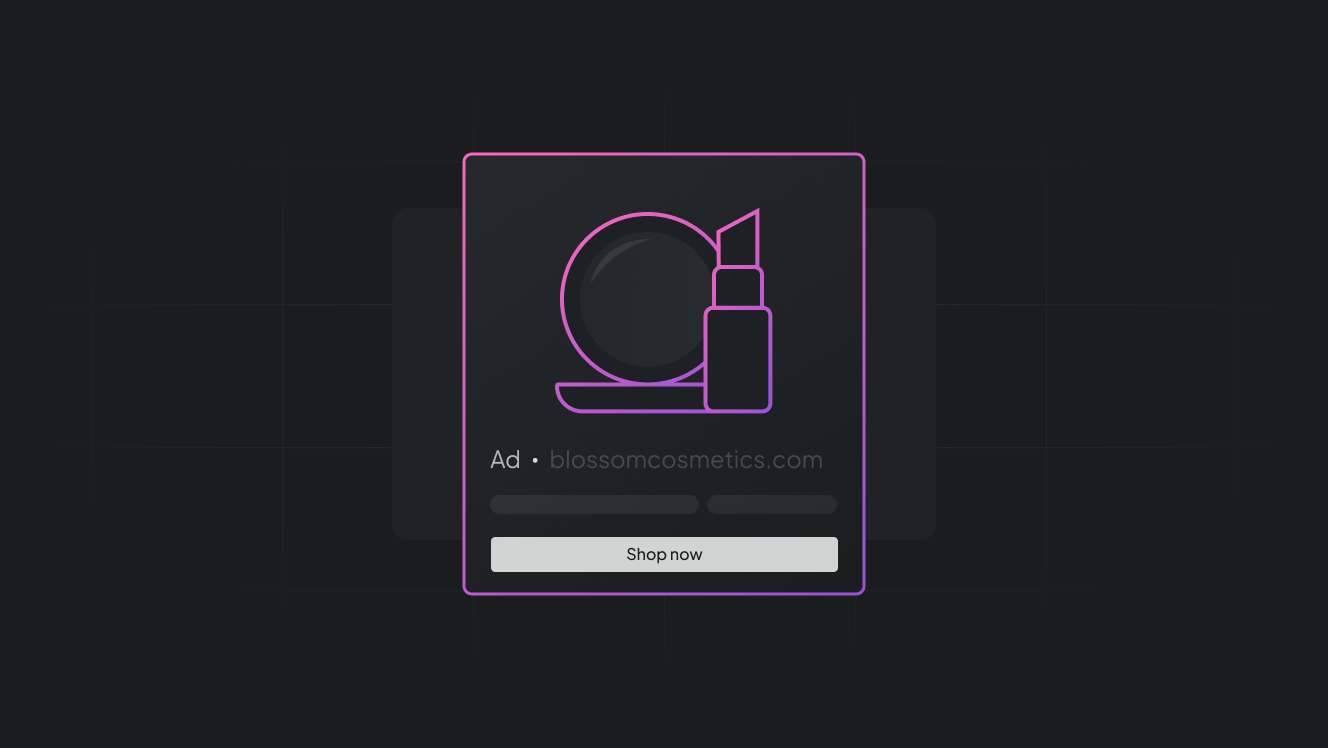
The cosmetics industry is expected to generate US$677.19bn in 2025.
Much of this revenue is realized via advertising, seeing that companies in this industry also spent an estimated $7.7 billion on advertising in 2022.
It’s therefore safe to say that the competition here is cutthroat, and it takes a lot for your ads to stand out, let alone convert.
To give you a little edge, today’s guide will show you examples of cosmetics ads that you can replicate successfully in your own campaigns.
For each of the cosmetics ad examples, we will tell you which elements worked and how you can use the same or improve them for your business.
Key takeaways
- The best cosmetics ads capitalize on brand authority by displaying logos and credibility markers.
- Consumers care about what they're putting on their skin, so including formulations and ingredient details is always good practice for cosmetics ads.
- Use multiple product angles and usage shots to help customers visualize the actual experience of your product.
- If you're unsure what to include in catalog ads, product info, price, and benefits are always safe bets.
Best cosmetics ad examples for Facebook
We’re using Facebook catalog ads for most examples because while they might take some time to set up, they’re one of the best ads to use in this industry.
Once live, catalog ads become the gift that keeps giving. They update dynamically, can be scheduled around seasonal campaigns, and stay relevant thanks to automatic feed updates.
Now that we have that out of the way, find below a few handpicked cosmetics ad examples we liked.
1. Show product + brand authority
Cosmetics consumers are super brand-conscious. Before they care about what the product does, they want to know where it comes from.
The best-performing beauty ads will show the product, highlight the brand name, and build trust by communicating credibility at a glance.
L'Oréal doesn’t need an introduction, but they don’t assume that brand recognition alone will do the heavy lifting.
In the cosmetic ad example below, they combine name recognition with clear, benefit-led messaging.
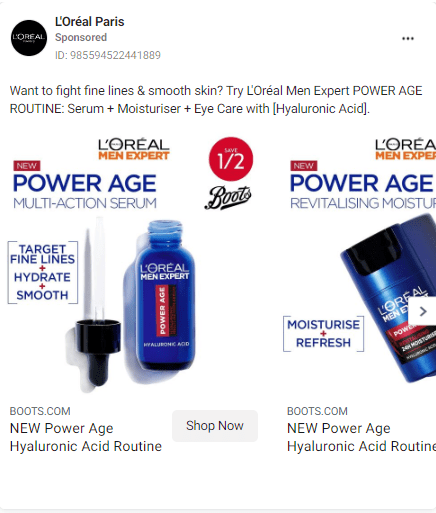
The layout is clean but intentional, and the product sits against a simple, well-lit background that draws the eye without overwhelming it.
The logo is part of the visual, not something tucked away in a corner or left to the caption. And the supporting text tells you what the product will do for your skin.
In this other example, still from L'Oréal, they don’t include the brand name in the creatives, but they show the users the before and after of using their products. It’s still an effective way to show a product’s benefits.
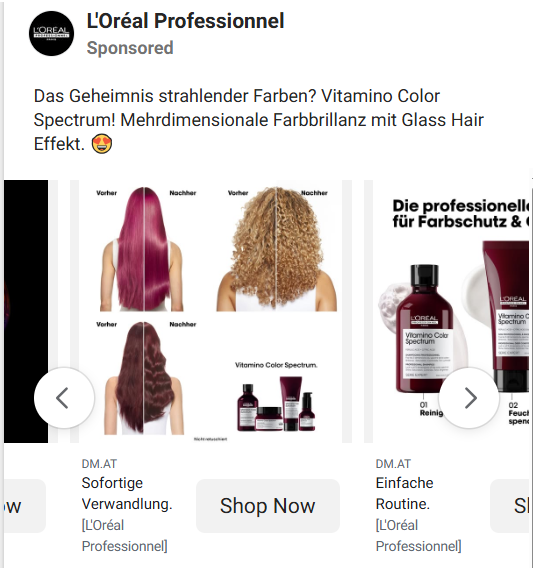
Even if you are a well-known brand, wherever possible, connect product features to tangible results that the user can expect and show that on your ads.
You can also see Bath & Body Works use the same benefit-driven messaging in the example below.
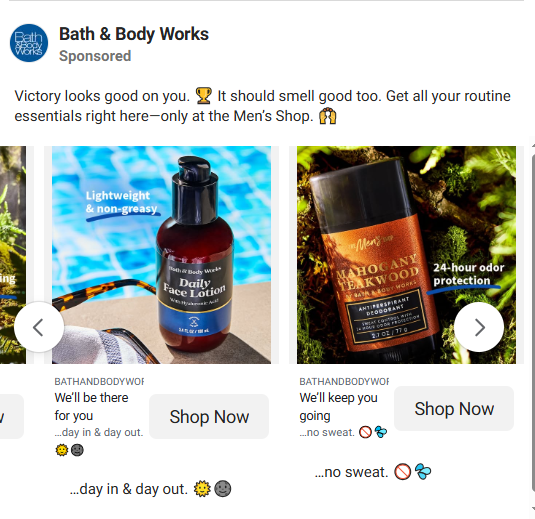
2. Use multiple product angles
Users shopping for cosmetics always want to get a hyperrealistic image of what it feels like to use your products.
So yes, include a packshot of the product, but show the product in use for a hyperrealistic push.
See Lancôme’s ad below. There’s a prominent product image, and then in the next slide, users get to see what that lip gloss looks like on a person. Lancôme supports the images with more details about the product composition and a little bit about the benefits.

We see a similar pattern with this other Sephora ad.
A model introduces the ad visually, creating that initial connection, while the second frame follows up with the full product range.
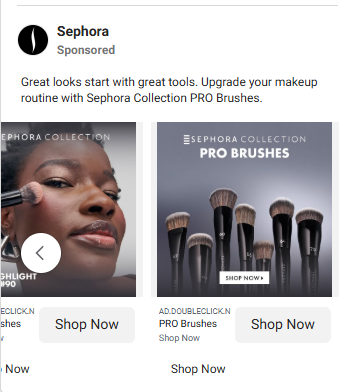
For a first-time viewer, that sequence answers what the product looks like in use and what options are available.
Here’s another example from Sephora, this time for blushes. The ‘only at Sephora’ banner is a nice tactic of baking exclusivity into an ad.
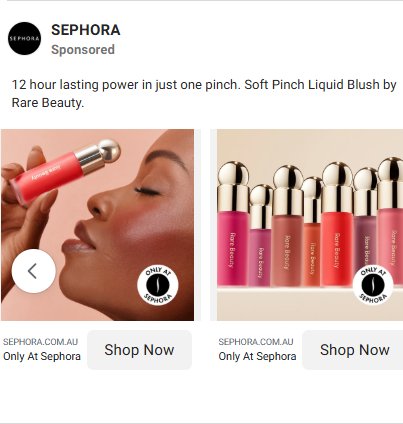
In your case, you can do limited edition products, or if you have physical stores, decide that it’s only available in select stores.
Another tactic when working with multiple images is to include color swatches to create that hyperrealistic feel about your products.
See the Ulta Beauty example below.
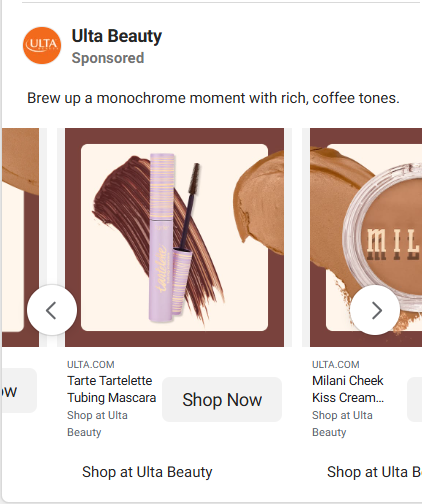
3. Layer product information
In high-intent categories like skincare and makeup, buyers are already comparing benefits, ingredients, coverage levels, and skin compatibility before they click.
If your ads don’t surface that information upfront, you lose them to someone who does.
Make sure to state the most important product ingredient or composition, like this e.l.f. ad.
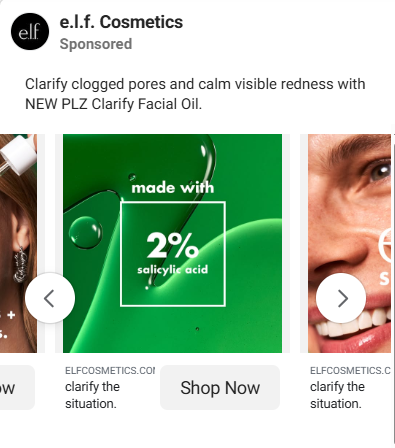
You can also be more generous with the details accompanying your product images. See Ulta Beauty and Sephora examples.
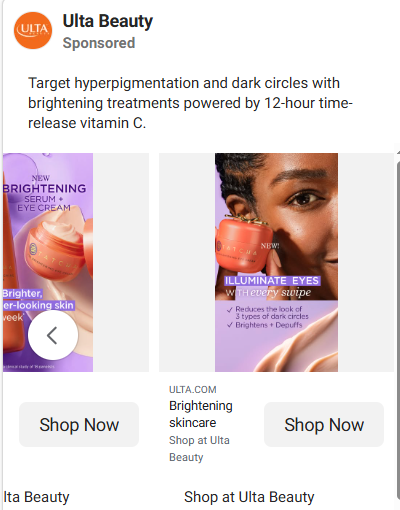
Even if you choose to keep it simple, show, or at least tell, what your product helps a user achieve.
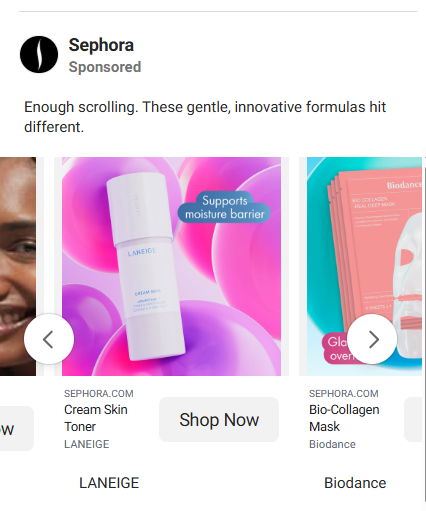
Also, spotlight the pack sizes or sets in your ads. You can see how Sephora calls out that the product is a #4pack.
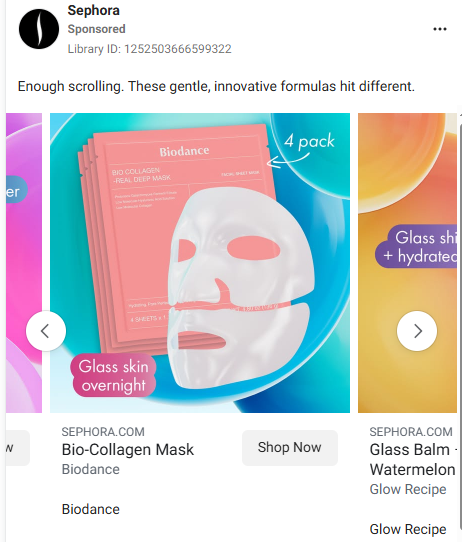
When customers see they're getting a lip set with four shades or a skincare routine with three products, it helps them understand the value proposition immediately.
The most effective cosmetics ads treat product information as a selling tool. Your customers want to make informed decisions, so give them everything they need to feel confident about clicking through.
4. Use seasonal elements
For holiday and seasonal campaigns, incorporate the holiday colors into your ads.
For example, Bath and Bath and Body Works uses red and green to mirror Christmas colors.
Even though they don’t explicitly mention Christmas in their ads, users can tell it’s a Christmas promo by looking at it.
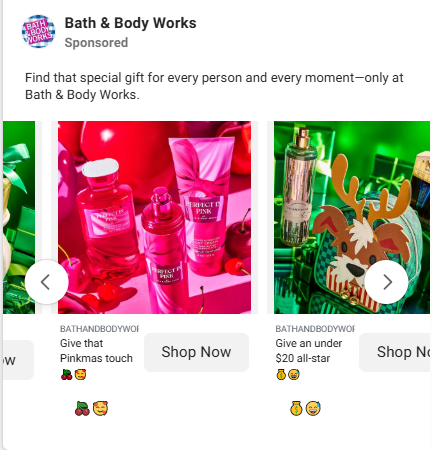
You can also use the color tactic for Black Friday, Halloween, etc. Check out these Black Friday marketing examples to see that in action.
Aside from colors, holiday paraphernalia is yet another way to tap into the holiday shopping mindset.
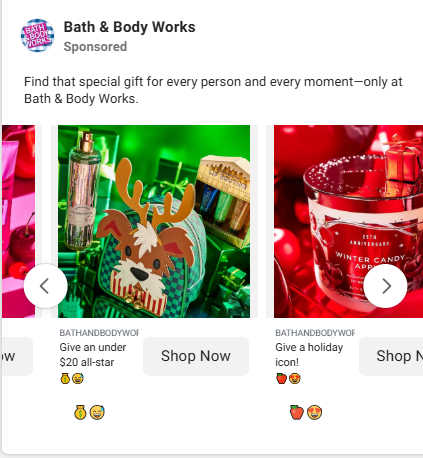
5. Leverage urgency tactics
Urgency is one of the best psychological triggers to motivate customers to buy quickly.
If you’re wondering how to implement that in your ads, look at the Cozmetica example below. They prominently display the 30% discount, but also tell you it’s a limited offer, so if a user wants to benefit from it, they better act fast.
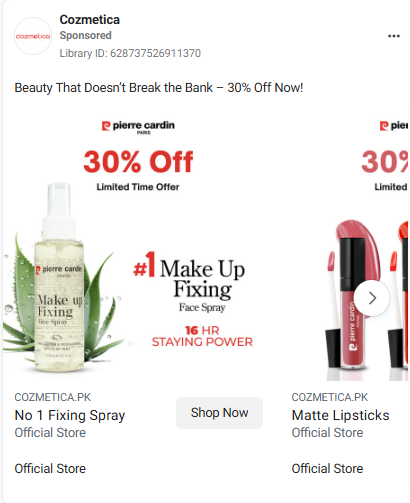
Even a simple, toned-down banner with the discount, like this cosmetic ad example, is still a good start.
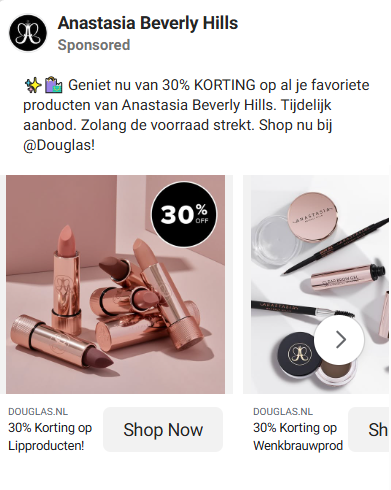
6. Highlight new products or sets
Newness is one of the easiest ways to win attention and clicks, but it only works if your ad calls it out clearly.
You can go all flashy with your announcement or use a simple call-out banner like these examples from Ulta Beauty.
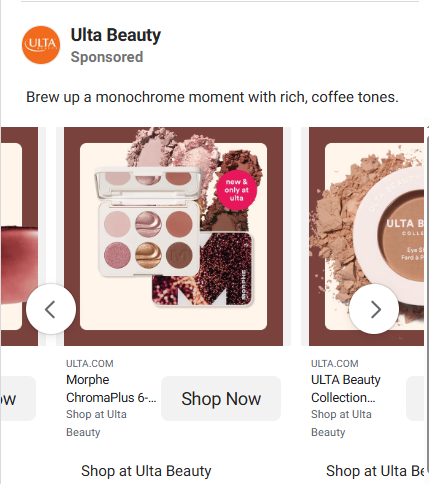
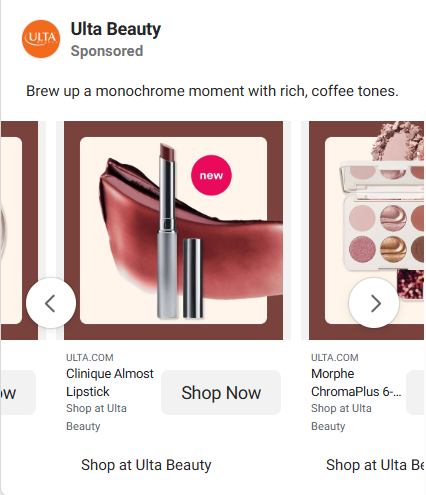
7. Curate sets for specific looks or occasions
The most effective way to sell collections is to create curated product sets. But don’t do it randomly. Take inspiration from Ulta Beauty by curating according to occasions.
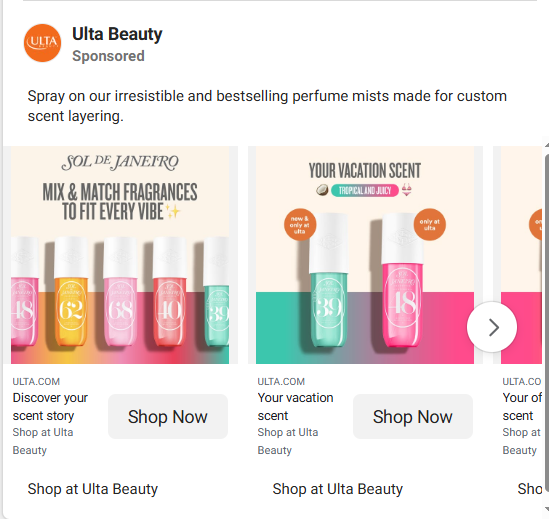
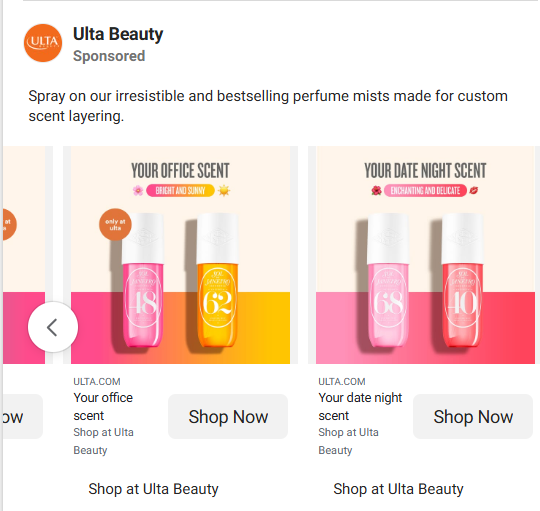
8. Show credibility
Users today want to know that what they’re putting on their face or body is not only effective but also safe.
One of the best ways to show this credibility is by combining social proof and expert validation.
In the example ad, the caption mentions 10,000+ five-star reviews. That’s your first layer of proof. Then, in the catalog ad itself, they feature a user review. That’s proof number two.
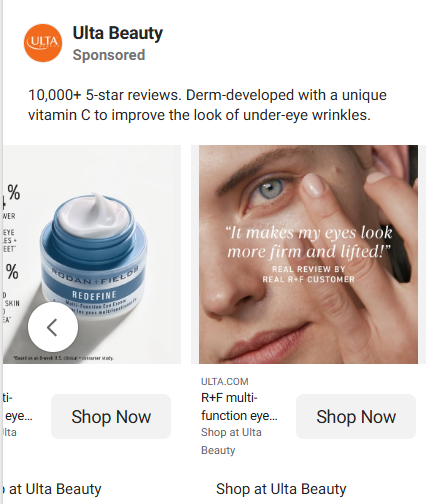
If you have the stats in addition to the user reviews, don’t forget to showcase them too.
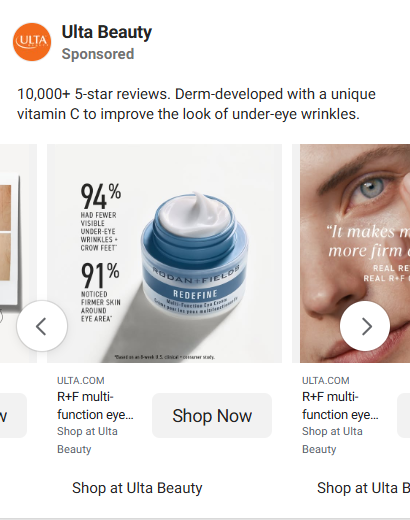
Another way to bring in some credibility is to mention that a product is dermatologist-recommended.
Of course, you should have data to back this up, but this simple callout is a trust signal that can tip the scales for skeptical shoppers.
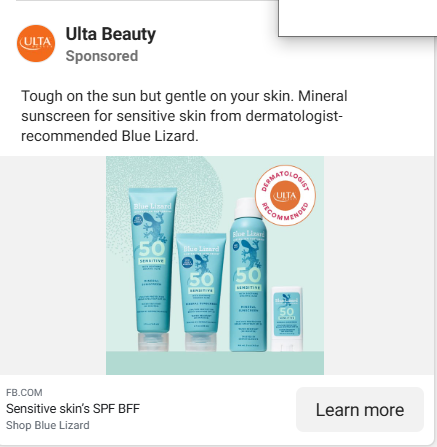
9. Don’t shy away from single, dynamic catalog ads
Most catalog ads are carousel by default, but you’re not limited to that format. Single image or video ads can be just as resourceful when you want to spotlight a discount, new launch, or hero product.
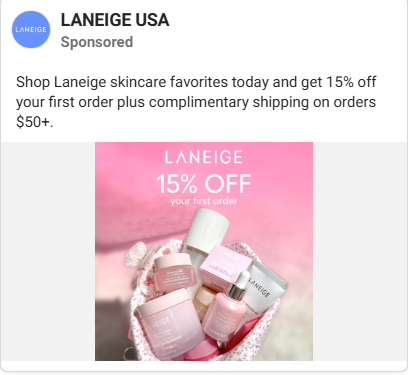
10. Add some motion to your catalog ads
Product-level videos are another must-use tactic to consider for your cosmetics ads. You can even pair them with static image ads to create variation within your catalog.
Laneige USA is a good example. Instead of overproduced footage, they keep it as a short clip showing the product. It adds just enough movement to catch the eye without taking focus away from the product.

11. Compete on price
If your prices give you a competitive edge, show them off in your ads.
e.l.f.’s catalog ads highlight affordable options without being loud about it. The pricing is visible, the product quality is still front and center, and it's clear that you don’t have to spend a lot to get great results with this brand.
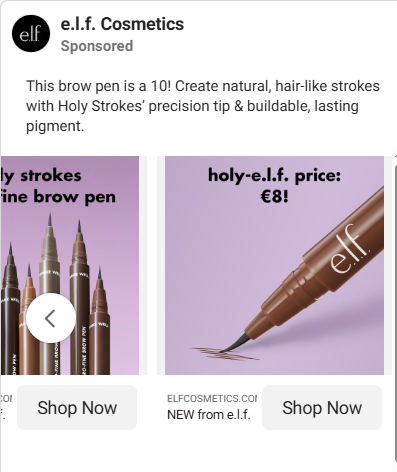
You can see e.l.f. do it again with these two examples below.
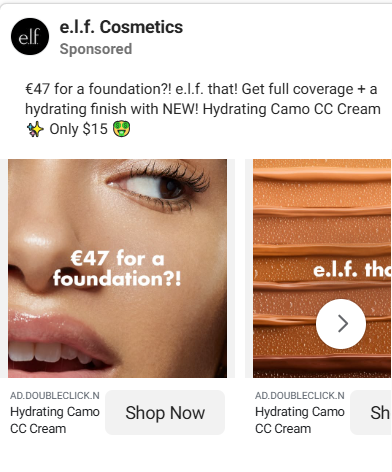
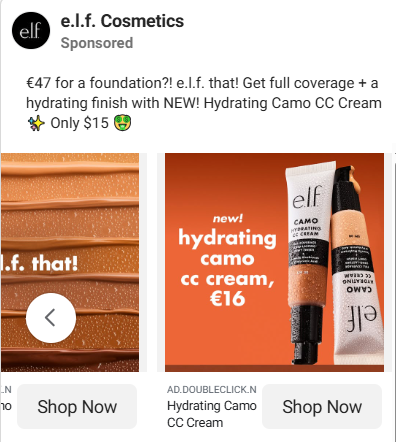
Final thoughts
Advantage+ catalog ads are one of the best ways to gain a competitive advantage in your ad strategy. According to Meta, these ads can result in a 17% decrease in CPA and a 32% increase in ROAS.
But for them to be persuasive, you’ll need to incorporate elements that move the needle on clicks and conversions.
To start, take a few elements from the above cosmetics ad examples and implement them bit by bit.
If you’ve mastered the elements to include and are now looking to scale, Cropink has the tools you need.
Book a demo to find out how you can create hundreds of catalog ads automatically from your product feed.
FAQs
Focus on one clear benefit your customer cares about, then back it with proof. Skip clever wordplay and lead with what the product does for them. Bold visuals paired with simple, direct copy almost always outperform elaborate messaging.
Show the product in use and include details like ingredients or shades upfront so customers don't have to guess. Adding social proof and competitive pricing will also help push hesitant buyers over the line.
Yes, you can combine both formats within the same catalog ad campaign. Use videos that show products in action and complement that with static images to handle detailed product shots and specifications.
Sources

Damaris is a Digital Marketing Specialist who writes about digital marketing and performance marketing. At Cropink, she creates data-driven content to help businesses run better ad campaigns for better performance and ROI.

Leszek is the Digital Growth Manager at Feedink & Cropink, specializing in organic growth for eCommerce and SaaS companies. His background includes roles at Poland's largest accommodation portal and FT1000 companies, with his work featured in Forbes, Inc., Business Insider, Fast Company, Entrepreneur, BBC, and TechRepublic.
Related Articles
Crafting a successful Christmas ad campaign means blending festive spirit, storytelling, and smart marketing strategies. From iconic brand examples to essential tools, this guide helps you create ads that resonate and drive holiday sales.

Bringing independent creatives together to work as a team can be a challenge, especially in fast-paced marketing environments. Learn how to overcome communication barriers, set clear goals, and use smart project management to boost collaboration and deliver great results.

Pinterest is no longer just for inspiration—it’s a performance marketing powerhouse. Discover 7 ad formats, from AR Try On to shoppable Idea Ads, and learn how Pinterest drives high-intent traffic and sales in 2025.

Looking for the perfect Valentine’s Day slogan? Explore catchy, cute, and creative Valentine slogans for cards, gifts, marketing campaigns, and more!

Struggling to get clicks? Learn how to write ad text that converts in 2026—by focusing on emotions, benefits, and mobile-first copy. Discover proven tactics, from urgency to personalization tools like Cropink.

Showcase Shopping ads were a powerful tool for upper-funnel product discovery, but they were officially retired in 2021. This comprehensive guide explains the original ad format and provides a strategy for replicating its broad search and visual storytelling success using the modern Google campaign types.

Pinterest ads do not fail because of budgets. They fail because of small rule breaks. This simple 2026 guide shows you exactly what Pinterest approves, what it blocks, and how to design ads that blend into the platform and actually perform. If you want fewer rejections and better results, this is the checklist you should read before launching your next campaign.

With 76% of consumers planning to celebrate Father's Day, the revenue opportunity is huge, but so is the competition. This guide shows you seven creative Father's Day ads that stood out for the right reasons. Learn the tactics these brands used and how you can adapt them for your own products or services.

The objectives of advertising in 2026 go beyond awareness. With 63% of global ad spend now digital and triggered emails converting 88% better, brands must align goals like lead generation, loyalty, and engagement to maximize ROI. Learn how strategic ads deliver results.

Bandwagon advertising uses social proof to influence buyer behavior. With 69% of millennials driven by FOMO and 20% of consumers influenced by celebrities, popularity becomes a growth engine. See how to turn engagement into conversion using real-time tactics and creative tools.

Creating a successful ad campaign is a science, not a gamble. This comprehensive 8-step guide provides the framework you need to launch your first profitable ad and continuously optimize for maximum return.

Discover how to tap into Facebook Messenger’s 947 million users in 2026. Learn how Messenger ads drive real engagement by starting direct conversations—right where your audience is already active.

How Can Cropink Help?
Start with Cropink is easy and free
No credit card required